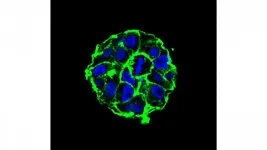(Press-News.org) Interim analysis from phase 3 trial of nearly 20,000 participants suggests efficacy of two-dose regimen of the adenovirus-based vaccine is 91.6% against symptomatic COVID-19 - trial reports 16 COVID-19 cases in the vaccine group (0.1% [16/14,964) and 62 cases (1.3% [62/4,902]) in the placebo group.
No serious adverse events were deemed to be associated with vaccination, and most reported adverse events were mild, including flu-like symptoms, pain at injection site and weakness or low energy.
Sub-analysis of 2,000 adults older than 60 years suggests the vaccine is similarly effective and well tolerated in this group.
Trial is ongoing and aiming to include a total of 40,000 participants - monitoring of safety and efficacy continues.
An interim analysis of data from the phase 3 trial of the COVID-19 vaccine from Russia (Gam-COVID-Vac) suggests that a two-dose regimen of the adenovirus-based vaccine offers 91.6% efficacy against symptomatic COVID-19. The preliminary findings, published in The Lancet, are based on analysis of data from nearly 20,000 participants, three-quarters of whom received the vaccine and one quarter received a placebo.
Serious adverse events (those requiring hospital admission) were rare in both the placebo (0.4% [23/5,435]) and vaccine (0.2% [45/16,427]) groups and none were considered associated with vaccination. Four deaths were reported in the trial, none of which were considered related to the vaccine. Most reported adverse events were mild, including flu-like symptoms, pain at injection site and weakness or low energy.
The Gam-COVID-Vac is a two-part vaccine that includes two adenovirus vectors - recombinant human adenovirus type 26 (rAd26-S) and recombinant human adenovirus type 5 (rAd5-S) - which have been modified to express the SARS-CoV-2 spike protein. The adenoviruses are also weakened so that they cannot replicate in human cells and cannot cause disease. Adenoviral vector vaccines have been previously used, and their safety has been confirmed in several clinical studies.
In this trial, participants were given one dose of rAd26-S, followed by a booster dose of rAd5-S 21 days later. The authors explain that using a different adenovirus vector for the booster vaccination may help create a more powerful immune response (compared with using the same vector twice), as it minimises the risk of the immune system developing resistance to the initial vector.
"Our interim analysis of the randomised, controlled, phase 3 trial of Gam-COVID-Vac in Russia has shown high efficacy, immunogenicity, and a good tolerability profile in participants aged 18 years or older," says Dr Inna V Dolzhikova, co-lead author, Gamaleya National Research Centre for Epidemiology and Microbiology, Russia. [1]
Worldwide, 64 candidate COVID-19 vaccines are currently in clinical assessment (including 13 vaccine candidates at phase 3) and 173 vaccines are in preclinical analyses. Phase 3 candidate vaccines include a variety of vaccine platforms, such as vector vaccines, mRNA vaccines, inactivated vaccines, and adjuvanted recombinant protein nanoparticles.
"Stopping the COVID-19 pandemic requires the introduction of different vaccines based on different mechanisms of action to cover diverse global health demands. Our vaccine, along with other SARS-CoV-2 vaccines, helps to diversify the world SARS-CoV-2 vaccine pipeline," says Dr Denis Logunov, co-lead author, Gamaleya National Research Centre for Epidemiology and Microbiology, Russia. [1]
Between Sept 7 and Nov 24, 2020, a total of 21,977 adults were randomly assigned to receive the vaccine (16,501) or placebo (5,476). The trial was conducted across 25 hospitals and polyclinics in Moscow, Russia. 14,964 participants in the vaccine group and 4,902 in the placebo group received two doses of the vaccine or placebo and were included in the primary interim efficacy analysis reported today. PCR tests were done at screening and at dose 2 (21 days). A further PCR test was done if participants reported symptoms of respiratory infection. Efficacy of the vaccine was calculated on the basis of the proportion of participants with PCR-confirmed COVID-19.
From 21 days after receiving the first dose (the day of dose 2), 16 cases of symptomatic COVID-19 were confirmed in the vaccine group (0.1% [16/14,964) and 62 cases (1.3% [62/4,902]) in the placebo group - equivalent to an efficacy of 91.6%.
The vaccine induced a robust humoral response (also called antibody response) and cellular immune response (also called T-cell response) with data from 342 and 44 participants, respectively. Six of the 342 participants did not mount an immune response following vaccination, possibly due to older age or individual characteristics.
The authors note that because COVID-19 cases were detected only when participants self-reported symptoms (followed by a PCR test), the efficacy analysis only includes symptomatic cases of COVID-19, and further research is needed to understand the efficacy of the vaccine on asymptomatic COVID-19, and transmission. Furthermore, median follow up was 48 days from the first dose, so the study cannot assess the full duration of protection.
Adverse events were monitored via electronic medical records, electronic diaries and telemedicine consultations. Data on serious adverse events were analysed for 21,862 participants who received at least one dose of the vaccine (16,427) or the placebo (5,435). 70 serious adverse events were reported in 68 participants, including 45 (0.2% [45/16,427]) participants in the vaccine group, and 23 (0.4% [23/5,435]) participants in the placebo group. None of the serious adverse events were considered associated with vaccination.
During the trial, four deaths were recorded - three ( END
The Lancet: Study reports preliminary efficacy and safety results from interim analysis of Russian COVID-19 phase 3 vaccine trial
2021-02-02
ELSE PRESS RELEASES FROM THIS DATE:
Toward safer steroids: Scientists devise method for improving safety of drug used to treat COVID-19, autoimmune disorders and more
2021-02-02
JUPITER, FL - A collaboration led by Scripps Research has developed a way to separate the beneficial anti-inflammatory properties of a group of steroids called glucocorticoids from some of their unwanted side-effects, through an optimization process they named "ligand class analysis."
Their process enabled them to engineer two new, drug-like compounds that show steroidal anti-inflammatory action and other specific traits. One boosts muscle and energy supply, while the other reduces risk of muscle-wasting and bone loss typical of such drugs.
Their report, titled, "Chemical systems biology ...
Moffitt researchers identify why CAR T therapy may fail in some lymphoma patients
2021-02-02
TAMPA, Fla. -- Chimeric antigen receptor T-cell therapy, or CAR T, has been a breakthrough in the treatment of blood cancers such as acute lymphoblastic leukemia and diffuse large B-cell lymphoma. Clinical studies have shown overall response rates of more than 80% with an ongoing response of nearly 40% more than two years after therapy. However, the cellular immunotherapy doesn't work for every patient. Moffitt Cancer Center, one of the leading centers for cellular immunotherapy, is researching why some patients have a better CAR T response than others and what can be done to improve the treatment's effectiveness. In a new study ...
Modeling the brain during pain processing
2021-02-02
The many different sensations our bodies experience are accompanied by deeply complex exchanges of information within the brain, and the feeling of pain is no exception. So far, research has shown how pain intensity can be directly related to specific patterns of oscillation in brain activity, which are altered by the activation and deactivation of the 'interneurons' connecting different regions of the brain. However, it remains unclear how the process is affected by 'inhibitory' interneurons, which prevent chemical messages from passing between these regions. Through new research published in EPJ ...
NREL reports sustainability benchmarks for plastics recycling and redesign
2021-02-02
Researchers developing renewable plastics and exploring new processes for plastics upcycling and recycling technologies will now be able to easily baseline their efforts to current manufacturing practices to understand if their efforts will save energy and reduce greenhouse gas emissions.
Benchmark data calculated and compiled at the National Renewable Energy Laboratory (NREL) provide a measurement--at the supply chain level--of how much energy is required and the amount of greenhouse gases emitted from the production of a variety of plastics in the United States.
"Today, we employ a predominantly linear economy for many of the materials we use, including plastics," said Gregg Beckham, a senior research fellow at NREL. "Many people ...
Textile sensor patch could detect pressure points for amputees
2021-02-02
A soft, flexible sensor system created with electrically conductive yarns could help map problematic pressure points in the socket of an amputee's prosthetic limb, researchers from North Carolina State University report in a new study.
In IEEE Sensors Journal, researchers from North Carolina State University reported on the lightweight, soft textile-based sensor prototype patch. The device incorporates a lattice of conductive yarns and is connected to a tiny computer. They tested the system on a prosthetic limb and in walking experiments with two human volunteers, finding the system could ...
Hydrogen-producing enzyme protects itself against oxygen
2021-02-02
An international research team from the Photobiotechnology Research Group at Ruhr-Universität Bochum (RUB) led by Professor Thomas Happe and the Laboratoire de Bioénergétique et Ingénierie des Protéines (CNRS) in Marseille has been able to get to the bottom of this unique feature. They describe the molecular mechanism in Nature Communications on 2 February 2021.
Enzyme repeatedly survives the attack unharmed
Representatives of the [FeFe]-hydrogenase enzyme group combine protons and electrons to form molecular hydrogen at particularly high turnover rates. Some of them even use sunlight as a primary energy source ...
Geisinger-GeneDx research identifies frequent genetic causes of cerebral palsy
2021-02-02
DANVILLE, Pa. and GAITHERSBURG, Md. - Researchers have discovered a strong link between genetic changes known to cause neurodevelopmental disabilities and cerebral palsy.
Cerebral palsy affects movement and posture and often co-occurs with other neurodevelopmental disorders, including intellectual disability, epilepsy and autism spectrum disorder. Individual cases of cerebral palsy are often attributed to birth asphyxia, although recent studies indicate that asphyxia accounts for less than 10% of cases. A growing body of research indicates that cerebral palsy may be caused by genetic changes, ...
New tool facilitates inclusion of people of diverse ancestry in large genetics studies
2021-02-02
BOSTON -- Genome-wide association studies (GWAS) have typically excluded diverse and minority individuals in the search for gene variants that confer risk of disease. Researchers at Massachusetts General Hospital (MGH), the Broad Institute of MIT and Harvard, and other institutions around the world have now developed a free-access software package called Tractor that increases the discovery power of genomics in understudied populations. A study of Tractor's performance and accuracy was published in END ...
Dementia rates higher in men with common genetic disorder haemochromatosis
2021-02-02
New research has found that men who have the Western world's most common genetic disorder are more likely to develop dementia, compared to those without the faulty genes.
Researchers at the University of Exeter and the University of Connecticut have previously found that men with two faulty genes that cause the iron overload condition haemochromatosis are more likely to develop liver cancer, arthritis and frailty, compared to those without the faulty genes.
Now, the team's new analysis of more than 335,000 people of European ancestry in UK Biobank, ...
Cancer research expands body's own immune system to kill tumors
2021-02-02
WASHINGTON, February 2, 2021 -- Scientists are hoping advances in cancer research could lead to a day when a patient's own immune system could be used to fight and destroy a wide range of tumors.
Cancer immunotherapy has some remarkable successes, but its effectiveness has been limited to a relatively small handful of cancers. In APL Bioengineering, by AIP Publishing, a team from Stanford University and Genentech describes how advances in engineering models of tumors can greatly expand cancer immunotherapy's effectiveness to a wider range of cancers.
"One of the biggest breakthroughs we've had in cancer research in decades is that we can modify the cells in your own immune system to make them kill cancer cells," said author Joanna Lee.
Using ...

